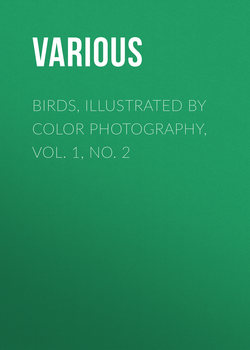Читать книгу Birds, Illustrated by Color Photography, Vol. 1, No. 2 - Various - Страница 3
THE RED HEADED WOODPECKER
ОглавлениеPERHAPS no bird in North America is more universally known than the Red Headed Woodpecker. He is found in all parts of the United States and is sometimes called, for short, by the significant name of Red Head. His tri-colored plumage, red, white and black, glossed with steel blue, is so striking and characteristic, and his predatory habits in the orchards and cornfields, and fondness for hovering along the fences, so very notorious, that almost every child is acquainted with the Red Headed Woodpecker. In the immediate neighborhood of large cities, where the old timber is chiefly cut down, he is not so frequently found. Wherever there is a deadening, however, you will find him, and in the dead tops and limbs of high trees he makes his home. Towards the mountains, particularly in the vicinity of creeks and rivers, these birds are extremely numerous, especially in the latter end of summer. It is interesting to hear them rattling on the dead leaves of trees or see them on the roadside fences, where they flit from stake to stake. We remember a tremendous and quite alarming and afterwards ludicrous rattling by one of them on some loose tin roofing on a neighbor’s house. This occurred so often that the owner, to secure peace, had the roof repaired.
They love the wild cherries, the earliest and sweetest apples, for, as is said of him, “he is so excellent a connoisseur in fruit, that whenever an apple or pear is found broached by him, it is sure to be among the ripest and best flavored. When alarmed he seizes a capital one by striking his open bill into it, and bears it off to the woods.” He eats the rich, succulent, milky young corn with voracity. He is of a gay and frolicsome disposition, and half a dozen of the fraternity are frequently seen diving and vociferating around the high dead limbs of some large trees, pursuing and playing with each other, and amusing the passerby with their gambols. He is a comical fellow, too, prying around at you from the bole of a tree or from his nesting hole therein.
Though a lover of fruit, he does more good than injury. Insects are his natural food, and form at least two thirds of his subsistence. He devours the destructive insects that penetrate the bark and body of a tree to deposit their eggs and larvae.
About the middle of May, he begins to construct his nest, which is formed in the body of large limbs of trees, taking in no material but smoothing it within to the proper shape and size. The female lays six eggs, of a pure white. The young appear about the first of June. About the middle of September the Red Heads begin to migrate to warmer climates, travelling at night time in an irregular way like a disbanded army and stopping for rest and food through the day.
The black snake is the deadly foe of the Red Head, frequently entering his nest, feeding upon the young, and remaining for days in possession.
“The eager school-boy, after hazarding his neck to reach the Woodpecker’s hole, at the triumphant moment when he thinks the nestlings his own, strips his arm, launches it down into the cavity, and grasping what he conceives to be the callow young, starts with horror at the sight of a hideous snake, almost drops from his giddy pinnacle, and retreats down the tree with terror and precipitation.”
